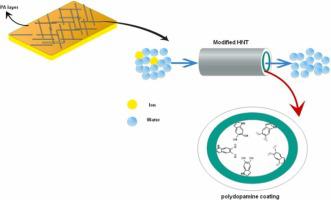Process Safety and Environmental Protection ( IF 6.9 ) Pub Date : 2021-11-23 , DOI: 10.1016/j.psep.2021.11.005 Z. Fallahnejad 1 , Gh. Bakeri 1, 2 , A.F. Ismail 3

|
The high concentrations of heavy metal ions in industrial effluents are one of the most challenging wastewaters to deal with. In this study and in order to change the inner diameter of the halloysite nanotubes (HNT), their internal surface was coated by different polymers (polydopamine, polyaniline and polystyrene) and then, the modified nanotubes were incorporated in the polyamide thin film NF membrane for the treatment of metal ions solutions. Fourier Transform Infrared Spectroscopy (FTIR), X-ray diffraction (XRD) and Brunauer-Emmett-Teller (BET) studies indicated that the internal coating was successful. Furthermore, the neat and modified nanofiltration (NF) membranes were characterized in terms of morphology, contact angle, water flux and metal ion rejection. The modified membranes displayed lower contact angle values (29.4% reduction) that can be linked to the hydrophilic groups in the structure of the coated polymers and the smoother surface of the thin film nanocomposite (TFN) membrane. In addition, the permeation fluxes of the modified membranes were improved significantly (33.4% improvement) without any major reduction in their ion rejection; that shows HNTs act as the channels to transfer water through the membrane structure while the coating of the inner surface of HNT reduces the size of the channel and makes more repulsion and steric hindrance for the ion to pass through the nanotubes. Among the fabricated membranes, the NF membrane with 0.05 wt% polystyrene-coated HNT showed the lowest contact angle (55.30o) and the highest water permeation flux (27.51 L m-2 hr-1), compared to the neat TFC membrane (15.26 L m-2 hr-1) and the NF membrane with 0.05 wt% unmodified HNT (20.62 L m-2 hr-1).
中文翻译:

功能化埃洛石纳米管结合薄膜纳米复合纳滤膜处理含金属离子废水
工业废水中高浓度的重金属离子是最具挑战性的废水之一。在本研究中,为了改变埃洛石纳米管(HNT)的内径,在其内表面涂覆不同的聚合物(聚多巴胺、聚苯胺和聚苯乙烯),然后将改性纳米管掺入聚酰胺薄膜 NF 膜中。金属离子溶液的处理。傅里叶变换红外光谱 (FTIR)、X 射线衍射 (XRD) 和 Brunauer-Emmett-Teller (BET) 研究表明内涂层是成功的。此外,纯净和改性的纳滤 (NF) 膜在形态、接触角、水通量和金属离子截留方面进行了表征。改性膜显示出较低的接触角值 (29. 减少 4%),这可以与涂层聚合物结构中的亲水基团和薄膜纳米复合材料 (TFN) 膜的更光滑表面相连。此外,改性膜的渗透通量显着提高(提高了 33.4%),而其离子截留率没有明显降低;这表明 HNT 作为通道将水转移通过膜结构,而 HNT 内表面的涂层减小了通道的尺寸,并对离子通过纳米管产生了更多的排斥和空间位阻。在制造的膜中,具有 0.05 wt% 聚苯乙烯涂层 HNT 的 NF 膜显示出最低的接触角(55.30 此外,改性膜的渗透通量显着提高(提高了 33.4%),而其离子截留率没有明显降低;这表明 HNT 作为通道将水转移通过膜结构,而 HNT 内表面的涂层减小了通道的尺寸,并对离子通过纳米管产生了更多的排斥和空间位阻。在制造的膜中,具有 0.05 wt% 聚苯乙烯涂层 HNT 的 NF 膜显示出最低的接触角(55.30 此外,改性膜的渗透通量显着提高(提高了 33.4%),而其离子截留率没有明显降低;这表明 HNT 作为通道将水转移通过膜结构,而 HNT 内表面的涂层减小了通道的尺寸,并对离子通过纳米管产生了更多的排斥和空间位阻。在制造的膜中,具有 0.05 wt% 聚苯乙烯涂层 HNT 的 NF 膜显示出最低的接触角(55.30 这表明 HNT 作为通道将水转移通过膜结构,而 HNT 内表面的涂层减小了通道的尺寸,并对离子通过纳米管产生了更多的排斥和空间位阻。在制造的膜中,具有 0.05 wt% 聚苯乙烯涂层 HNT 的 NF 膜显示出最低的接触角(55.30 这表明 HNT 作为通道将水转移通过膜结构,而 HNT 内表面的涂层减小了通道的尺寸,并对离子通过纳米管产生了更多的排斥和空间位阻。在制造的膜中,具有 0.05 wt% 聚苯乙烯涂层 HNT 的 NF 膜显示出最低的接触角(55.30Ò)和最高水渗透通量(27.51 L M -2小时-1),相对于纯的TFC膜(15.26 L M -2小时-1)和NF膜用0.05%(重量)未改性的HNT(20.62 L M - 2小时-1)。











































 京公网安备 11010802027423号
京公网安备 11010802027423号